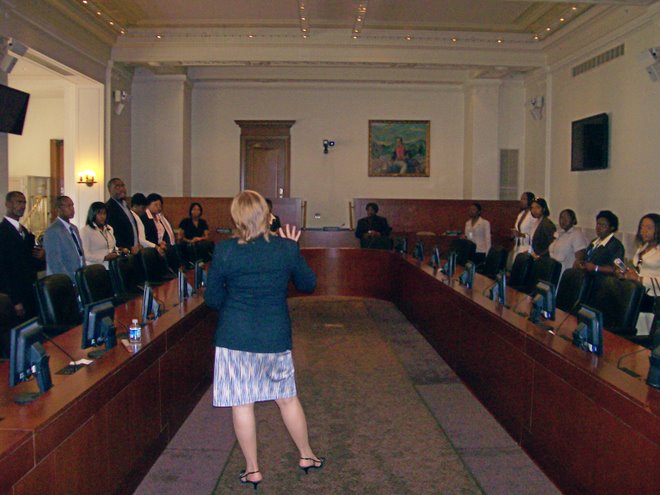
What is it? Why is it important? What can it contribute to a nation’s economic development? Understanding it from a manager’s viewpoint
The advances made in wireless communications, computer systems technologies and infrastructure, and application software have made government more efficient and responsive. Coupled with the Internet's global reach, governments can move rapidly to deliver services to their constituencies more efficiently and cheaply. Governments are on a long journey toward becoming electronic governments. There are three key questions for managers embarking on this journey: What is an electronic government? Why is it important? And, what can it contribute to a nation's development? To elaborate, this paper will address the five phases of e-government development. ----------------
What is electronic government (e-gov)?
In practical terms, e-gov is the use of the Internet and related technologies to facilitate communication between government and the general public, provide government information and services to citizens and business, and coordinate business processes internally and with other governments. However, electronic government is best understood in terms of the benefits it can provide to nations and their citizens. An ideal electronic government is easy to use, available to those with Internet access, private and secure, innovative and results-oriented, collaborative, cost-effective, and transformational.
The general goals of electronic government in the U.S., as identified by the President Bush’s “Expanding Electronic Government” initiative, are to:
• Make it easy for citizens to obtain service and interact with the federal government;
• Improve government efficiency and effectiveness; and
• Improve government’s responsiveness to citizens
In short, the goal of electronic government is to use the Internet to make government citizen-centric. ---------------------------
Why is e-gov important?

Citizens are becoming more accustomed to using online services from businesses and want the same online access to government information and services. Citizens see e-gov as a means to more accountability for government, greater public access to information, more efficient/cost effective government, and more convenient government services. E-gov also adds value. The E-Gov Strategy created by the U.S. Office of Management and Budget (OMB) (see the U.S.E-Government Strategy Submission) identified some key value added functions for e-gov:
• Simplifying delivery of services to citizens;
• Eliminating layers of government management;
• Making it possible for citizens, businesses, other levels of government and federal employees to easily find information and get service from the federal government;
• Simplifying agencies' business processes and reducing costs through integrating and eliminating redundant systems;
• Enabling achievement of the other elements of the President’s Management Agenda; and
• Streamlining government operations to guarantee rapid response to citizen needs. ----------------------------------------------------------------
What can it contribute to a nation's development?
Simplifying and streamlining government processes through e-gov can increase the effectiveness and impact of social services and reduce the burden on businesses wishing to receive services or comply with regulatory requirements. Programs that make Internet access publicly available can reduce the digital divide and create a demand for e-gov services. Many countries are exploring ways to make computers and Internet access available from libraries, post offices, banks, hospitals and other public locations. Along with trade promotion policies, the adoption of e-gov itself can help spur industry development in a country by providing a market for e-gov solutions.
E-government offers countries a chance to make their governments more accessible, accountable, efficient and responsive to citizen's needs. E-government is more than automating existing processes. It is a chance to change the relationship between governments and the citizens they serve, a key challenge for governments, including many in the developing world. E-government, for example, can enhance opportunities for citizen participation in regulatory processes. E-government also can help strengthen the rule of law by making laws and regulations more accessible. In addition, e-government can play a useful role in combating petty corruption by automating processes and allowing citizens to access information, apply for licenses and file taxes directly. Developing countries also can help attract investment by posting information online about the country's legal and regulatory framework that will help investors understand the legal and regulatory context for their investment decisions. Finally, e-government can help governments catalyze the use of the Internet, especially by their business communities, and spur the development of local content. It should be recognized, however, that e-government is part of a broader process of transformation and that there are risks of technical failure and underutilization of specific applications and services. Governments, particularly those of developing countries with scarce resources, need to be careful about how best to use resources and should focus initial e-government investments on proven technologies and high-impact applications.
The Five Phases of E-Gov

E-gov is an evolution for governments. The five phases outlined below represent the progression of many countries, including the United States in implementing E-Government and can serve as benchmarks for countries in assessing how far along they are in the evolution. However, these phases should not be taken as instructive of the best progression, nor are they intended to suggest that countries should blindly leap into advancing the process of E-Government.
The first three phases of implementation involve quick and relatively cheap online solutions. These phases—Information, Forms, and Transactions—involve automating and web-enabling existing business processes and programs. Little reinvention or process reengineering takes place. The U.S. Government is just emerging from this period with many lessons learned. ---
Phase 1: Information
In phase one, governments disseminate information. Agencies implement applications on the Internet that make electronic information readily accessible. This is clearly the easiest, least technically complex application to migrate. From a managerial perspective, little reengineering takes place. Examples include sites that provide online guides, and regulations, online manuals, inventory forms, and informational videos. ----
Phase 2: Forms
In phase two, agencies provide downloadable electronic forms for popular government services. Former President Clinton, in his December 17, 1999, Memorandum on Electronic Government, directed that “agencies shall, to the maximum extent possible, make available online, by December 2000, the forms needed for the top 500 Government services used by the public.”
Phase 3: Transactions
Phase three represents a more complex implementation of e-gov. It supports end-to-end transaction processing. Examples of these types of initiatives include the submission of patent applications via the Internet, obtaining information about a student loan, or making inquiries about the status of an immigrant visa application.
Phases 1-3 seem relatively straightforward and simple, however, ensuring effective and efficient e-gov development requires analysis and coordination across government agencies and functions.
Merging Islands of Automation
Phase 4: Integrated Transactions and One-Stop Portals
As the U.S. emerged from the first three phases of e-gov development, it was plagued by redundant systems, along with cost and process inefficiencies. The automation of business processes was done within traditional bureaucratic boundaries, which led to disparately managed information technology systems and online services. The bureaucratic inefficiencies of government were exacerbated in on online environment. Citizens seeking online information and services were confused. Phase four consists of coordinating these disparate systems to reduce duplication and inefficiencies while providing security and protecting privacy.
As governments begin to merge disparate systems, citizens begin to see integrated transactions and one-stop portals. The U.S. Government is embarking on this phase right now. In Fall 2000, the U.S. Government launched FirstGov.gov, its online portal for the U.S. Government. FirstGov provides a single entry-point to over 35 million federally maintained web pages from approximately 22,000 sites. The site organizes federal online content by customer and service, rather than by organization.
Integrated transactions are also beginning to appear. The Electronic Government Strategy created by the Office of Management and Budget identified 24 e-gov initiatives that cross government agencies. For example, the Integrated Acquisition Environment Initiative (IAE) is building upon online portals to contracting opportunities already available to businesses at FedBizOpps.gov and other sites. IAE envisions using the Internet to create a simpler, common, integrated business process for government buyers and sellers that promote competition, transparency and integrity. Emerging web service technologies and standards make service integration even more possible, but only if governments agree to the standards, and establish trust relationships and common business processes with business and government partners. This brings us to phase five.
Rethinking the role of government
Phase 5: Transformational
Phase five involves the change management and process reengineering necessary to truly transform government. A rethinking of established bureaucracies, funding mechanisms, intergovernmental management, and methods of citizen interaction with government is necessary to transform e-gov.
The transformational phase coincides with phase four in many respects. As governments merge transactions through one-stop portals for users, managing business processes and resources becomes an intergovernmental proposition. Managing e-gov programs that cut across government boundaries requires a new set of leadership skills. These skills include the art of negotiation, a vast knowledge of the culture and environment of partnering agencies, and the ability to manage to a goal without direct authority over team members.
The transformation of government using e-gov is also characterized by adherence to enterprise architecture. Government services are viewed as components of a governmentwide architecture. Emerging technologies will enable even greater coordination across systems. OMB’s E-Gov Strategy establishes the current enterprise architecture for the United States.
A source of funding and authority is needed to support transformational e-gov initiatives. Most vertical, program specific funding models in use do not adequately support horizontal intergovernmental initiatives. Without dedicated sources of funding for these initiatives, governments will continue to build highly stove-piped, process centered applications that do not adequately serve citizens, and cause costly redundancy in government services.
As technology enables more seamless communication with all government agencies, and citizens become more comfortable with and have greater access to the Internet, and when concerns about privacy and security are alleviated, citizen participation and engagement with government will also be transformed.
The benefit of lessons learned and new technologies will make it possible for countries just beginning their investments in e-gov to bypass some of the earlier phases. In the United States, managers are dealing with established agency systems that are maintained independently and having to build solutions to integrate them. There may be an opportunity for other countries to address the enterprise architecture, management, and funding issues prior to major investments in e-gov, thereby avoiding the inefficiencies, overlap, and fragmentation that the United States is dealing with in implementing its e-gov strategy.
A quote from a recent report by the Council for Excellence in Government illustrates the ideal vision of a transformed electronic government:
“Imagine government truly of, by and for the people--where individuals and organizations no longer wait in line between eight and five on weekdays only, but where they can be online any time or place they wish. A place not only to get information but also to complete transactions with government, get services, talk with elected representatives--even to vote. A government that organizes and furnishes information and services around the needs of people while protecting their privacy.” (E-government - The Next American Revolution, “ Council for Excellence in Government, January 2001)

















































































































-3.jpg)


.jpg)





.jpg)











.jpg)
.jpg)
.jpg)
.jpg)
.jpg)
.jpg)






































































No comments:
Post a Comment